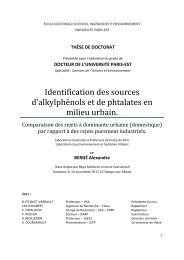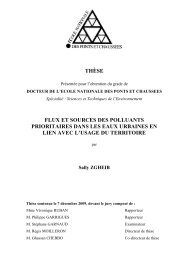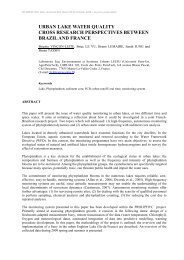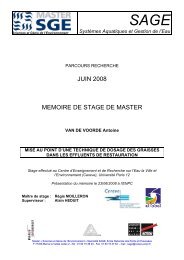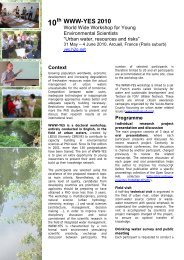View - ResearchGate
View - ResearchGate
View - ResearchGate
You also want an ePaper? Increase the reach of your titles
YUMPU automatically turns print PDFs into web optimized ePapers that Google loves.
charge of urban water infrastructure development, as long as urbanization and politicalplurality grew throughout the country, while different external frames of reference were alsowere exerting a strong influence in policy making, which was being mainly conceived andimplemented from the federal offices in charge of the issue (Pineda-Pablos, 2002).An emphasis should be put on analyzing the last 25 years, from the municipalization wave andthe related public tax and expenditure reforms. The rationale and the policies implemented tocreate and promote the evolution of municipal operators built as public firms, with aparticipatory governing body and a supporting scheme of master plans and financing programswould be analyzed in terms of their impact on investment in the sector and the evolution of aset of different cities. Although there are no homogeneous and complete sources ofinformation on the different public and private investment in urban water supply for thatperiod (1983-1989), at least a set of general trends would be sought. For the last period, theadaptation of the chosen cities and States to the evolution in demographic variables, sociopoliticaland financial environments, related to their outputs and performances, is expected toreveal some key processes regarding the role of the structuration of the relationships betweencollectivities and operators. A detailed exploration should be made in order to elucidatewhether some public policies can be considered as institutions in terms of their stability,degree of abstraction and generality and their normative character; their implementationdevices and processes should also be analyzed.A possible set for analyzing the proposed evolution would include:o Querétaro State, where state authority still operates water supply systems in everymunicipality but one; the capital city’s performance is amongst the best in the country.o Coahuila State, where there is a supporting state authority, as a mediator between federaland local authorities; the city of Saltillo has now a private participation scheme based onthe constitution of a mixed enterprise with interesting outputs.o Morelos State, where a supporting state authority has recently been createdo Aguascalientes State, whose capital was object of the first important integrated concessionof water services to a local partner of Véoliao Quintana Roo State, where the state authority still controls municipal water supply, withthe exception of Cancún, where there is a concession to a local partner of Ondeo.o Baja California State, where the city of Tijuana, operated by a state-dependant operator, isreputed to be the best managed water utility in Mexico.A detailed analysis in terms of the performance indicators available, the institutionalcharacteristics and comparability criteria would help to approach this analysis with morepertinence and precision.After a first stage, where the evolution of public policies in terms of their institutionalconsequences and the emergence of local arrangements would be analyzed, in a second stagesome elements would be sought to study which of these local responses have led to a moreeffective attainment of social goals. An identification of the core concepts for an institutionalanalysis would be instrumental, that is, the principal-agent relationship, the governancestructures, institutions or micro institutions (Ménard, 2003), the rules and the implementationdevices constituting the institutional environment. A selection of three representative cases –for instance, one where water supply would have been mantained under the centralized controlof the State authority, another one where municipalities rule the services and a third onehaving a mixed structure – is envisaged to delimit the research’s scope.Inherent to the idea of exploring alternative governance structures in terms of theircomparative effectivenes for attaining social goals, there is the idea of defining in a broaderfashion a urban water supply system’s objective structure, taking into account the expectedoutputs in terms of quality and reliability of services, but also its performance vis-à-vissustainability issues, that is, the way in which the system affects the resources whoseutilization right is exerted by the agent and the internal equilibria concerning the utilizationand complementarity of those resources, based on the definition presented in the previoussection. This formulation leads to the idea that the agent should need, in order to guide hisdecisions towards a better overall long-term integrated performance of the system, anaggregated way for evaluating the consequences of those decisions. The existence (or theabsence) of information systems or procedures leading to this kind of integrated evaluation ofperformance is considered as a potential analytical pivot for exploring governancemechanisms, as they imply internal and external transactions and interactions with internalagents and with external stakeholders. Therefore, the implementation of a strategicmanagement tool could serve as an auxiliary research learning device to explore and follow-uphow the effectiveness of transactions could be improved in a specific case. The collaborationwith a consulting firm to conceive and set up a model of Balanced Scorecard for water utilitiesis envisaged, in which consensual bottom-up evaluation of performance and specificperformace criteria, related to water supply sustainability, would be sought 51 .EXPECTED RESULTSThis research project could show different outputs:o It is expected to shed light on the origin of governance structures for urban water supply,whose diversity facing a similar policy context calls for an thoughtful explorationo A relationship between different local governance structures and performance, in terms ofthe transactional facilitation leading to effective, equitable and efficient results, in asustainable fashion, would be soughto The role of performance monitoring in internal and external agency relationships would beexplored, if possible undertaking a process of “governance engineering” by the conceptionand implementation of a strategic dashboard as a tool for revealing a deeper learning of theorganizational implications of performance steering in relation to effective governance.o Ultimately, a more general model for the analysis of governance structures in urban watersupply and sanitation, even a specific proposal of a model linked to the implementation ofa strategic management tool could be proposed.CONCLUSIONSNew institutional economics, in one hand, seem to furnish a powerful analytic grid to explorewhether some institutional arrangements show a greater effectiveness and, in that sense, ifsome kind of orientation in terms of public policy conception and implementation can beobtained. In the other hand, reflecting on the implications of embedding sustainabledevelopment issues in the definition of the overall objectives of a urban water supply system,thus constituting the broad “mandate” to the operator, conceived as the agent, leads us to theexploration of strategic performance management as a way to improving transactionseffectiveness and, in principle, as a possible device for reaching a deeper learning on howagency relationships occur within the organization and in its interactions with the external51 In González et al., 2006, a model proposed for a South American water operator is proposed.WWW-YES 2008, Paris 13 – 16 May 2008 125WWW-YES 2008, Paris 13 – 16 May 2008 126



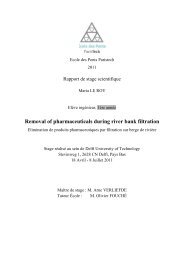
![[pastel-00730831, v1] Incidence des pratiques d'entretien ... - LEESU](https://img.yumpu.com/50938896/1/184x260/pastel-00730831-v1-incidence-des-pratiques-dentretien-leesu.jpg?quality=85)

